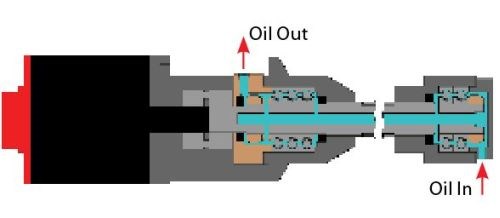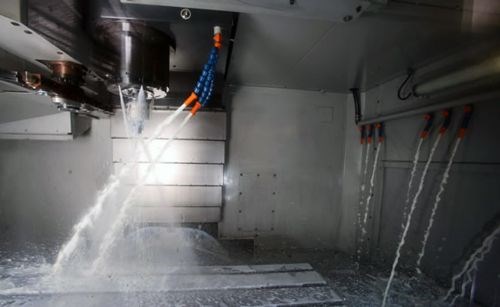Not all high-volume machining applications require HMCs. Many shops do well using lower-cost VMCs for production work. In some cases, though, a shop’s existing VMCs offer only modest spindle performance and relatively slow non-cutting functions, such as rapid traverse motions and tool changes. The resulting extended cycle times add up over long production runs, increasing overall manufacturing costs. That’s why Bill Howard, product line manager for Makino, says shops should leverage the latest VMC technologies engineered for high-volume production to minimize cycle times and maximize competitiveness. One example is the company’s new Production Standard (PS) series of VMCs, which provides not only a number of standard features to shrink cycle times, but also design elements that can effectively support a shop’s production efforts. These include:
• Improved spindle performance—The PS series of VMCs uses the same 40-taper spindle found in Makino’s a51 series of HMCs. It offers 33.5 horsepower, 14,000 rpm and 130 foot-pounds of torque. This spindle performance makes the PS series well-suited for a variety of applications and tough materials, while enabling shops to boost feed rates to minimize cutting time. It also enables shops to better utilize new, advanced cutting tool technologies to achieve increased material removal rates.
• Faster, quicker non-cutting functions—Fast rapid traverse rates minimize non-cutting time as the spindle is positioned to machine different areas of a workpiece. The PS series offers a rapid traverse rate of 1,417 ipm for X and Y axes, and 1,181 ipm for the Z axis. Also, quicker acceleration and deceleration reduce the distance needed when ramping up to (and down from) the machine’s rapid traverse rate. This enables the machine to be more productive, especially for parts with many closely spaced features. Chip-to-chip tool-change time of just 3.8 seconds also shrinks non-cutting time.
• Thermal control of spindles and linear axes—The PS series provides thermal control for all three axes. Temperature-controlled oil is circulated through the core of the X-, Y- and Z-axis ballscrews as well as their bearings, reducing thermal growth and machine warm-up time. In addition, a lower operating temperature extends the life of these components. Similarly, temperature-controlled oil is circulated through a jacket surrounding the spindle to control spindle temperature and minimize Z-axis growth.
• Increased positioning accuracy—In addition to the aforementioned features, the PS series includes other design elements that increase accuracy. Examples include minimal table overhang over the bed, reduced table weight and a ribbed column for improved strength and stability. The PS series delivers linear positioning accuracy of ±0.0001 inch and repeatability of ±0.000078 inch.
• Production support—The PS series is equipped with a variety of standard features to support a shop’s production efforts, including a scraper style, lift-up chip conveyor; 230-gallon coolant capacity; multiple points of coolant delivery, including flood, flush, overhead-shower and through-spindle; a table that can be positioned 8.3 inches away from operator to make part loading easier; and doors that open wider than the machine’s X-axis travel to ease loading of large parts. In addition, operators can access the toolchanger magazine and change tools while the machine is running to minimize spindle idle time during part change-over.
The PS series is available in two machine models: The PS65 features a 36.2- × 20.0-inch table, while the PS 95 provides a larger 46.0- × 20.0-inch table. A 30-tool ATC is standard for both VMCs, but an optional 60-tool ATC is available as is an add-on pallet changer.
One additional advantage Mr. Howard notes is that as of October, Makino has a healthy inventory of PS VMCs ready for immediate delivery from its Mason, Ohio facility. This is helpful for shops that have an urgent need to quickly add capacity to meet growing customer demand.

.jpg;width=70;height=70;mode=crop)






.jpg;maxWidth=300;quality=90)






.png;maxWidth=300;quality=90)











.jpg;maxWidth=970;quality=90)